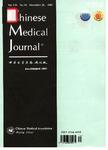Recurrent atrial tachycardia and atrial fribrillation after circumferential pulmonary vein ablation:What’s the difference?
Recurrent atrial tachycardia and atrial fribrillation after circumferential pulmonary vein ablation:What’s the difference?作者机构:Department of Cardiology Beijing Anzhen Hospital Capital University of Medical Science Beijing 100029 China
出 版 物:《Chinese Medical Journal》 (中华医学杂志(英文版))
年 卷 期:2005年第118卷第21期
页 面:1773-1778页
核心收录:
学科分类:1002[医学-临床医学] 100201[医学-内科学(含:心血管病、血液病、呼吸系病、消化系病、内分泌与代谢病、肾病、风湿病、传染病)] 10[医学]
主 题:atrial fibrillation catheter ablation pulmonary vein
摘 要:Background Recurrent atrial tachyarrhythmia (ATa) after circumferential pulmonary vein ablation (CPVA) includes atrial tachycardia (AT) and atrial fribrillation (AF). However, whether there are some differences in clinical course and mechanisms between the recurrent AT and the recurrent AF remained unclear. This study was conducted to investigate the incidence, mechanism, clinical course of the recurrent AT and AF in patients under *** One hundred and thirty consecutive patients (M/F = 95/35 ) with highly symptomatic ano multiple antiarrhythmic drugs (AADs) refractory paroxysmal ( n = 91 ) or persistent ( n = 39 ) AF were included. The ablation protocol consisted solely of two continuous circular lesions around the ipsilateral pulmonary veins (PV) guided by CARTO system. The endpoint of CPVA is PV isolation. For patients with recurrent ATa within 2 months after the initial procedure, cardioversion with direct current was attempted if the ATa lasted for more than 24 hours. A repeat ablation procedure was performed only for patients with AADs refractory recurrent ATa and at least followed up for 2 months after the initial *** Within 2 months after the initial procedure, 52 patients (40. 0% ) had experienced episodes of symptomatic recurrent ATa. Among them, 23 patients (44.2%) with recurred AT alone (AT group ), 14 patients (26.9%) with recurred AF alone (AF group), and 15 patients (28.8%) with recurred AT and AF (AT plus AF group). The delayed cure rate (65.2%) in AT group was significant higher than that in AF group (21.4%, P〈0.05) and AF plus AT group (26.7%, P 〈0.05). A repeat ablation was performed in 21 patients, including 6 patients with recurrent AT alone, 8 patients with recurrent AF alone, and 7 patients with recurrent AF plus AT. The mean number of PV gaps was 1.2 ± 0. 4 in AT group, which was significantly lower than that in AF group (2.6 ± 0. 7, P 〈 0.05) and AF plus AT group (2.0 ± 0.6, P 〈 0.05). Delayed cure rate and number of PV



